Progress in Research on Co-Packaged Optics
Abstract
:1. Introduction
2. Research Status and Application Prospects of CPO
2.1. Research Status of CPO
2.2. Application of CPO
2.2.1. Military Field
2.2.2. Data Center
2.2.3. Cloud Computing
3. Typical Package Form of CPO
3.1. CPO Based on 2D Packaging
3.1.1. CPO Based on Wire Bonding
3.1.2. Flip-Based CPO Technology
3.1.3. CPO Based on FOWLP
3.2. CPO Based on 2.5D Packaging
3.2.1. CPO Based on Silicon Interposer
3.2.2. CPO Based on Glass Interposer
3.2.3. CPO Based on EMIB
3.3. CPO Based on 3D Packaging
3.3.1. CPO with PIC as Interposer
3.3.2. CPO with EIC as Interposer
3.3.3. CPO Based on Organic Substrates
4. Challenges
4.1. Encapsulation Technology
4.2. Heat Dissipation Technology
4.3. Light Source Integration
4.4. Coupling Structure
4.5. Standardization
5. Conclusions
Author Contributions
Funding
Conflicts of Interest
References
- Du, Y.; Wang, F.; Hong, Z.; Shi, Y.; Chen, X.; Zheng, X. Detachable interface toward a low-loss reflow-compatible fiber coupling for co-packaged optics (CPO). Opt. Express 2023, 31, 1318–1329. [Google Scholar] [CrossRef] [PubMed]
- Minkenberg, C.; Krishnaswamy, R.; Zilkie, A.; Nelson, D. Co− packaged datacenter optics: Opportunities and challenges. IET Optoelectron. 2021, 15, 77–91. [Google Scholar] [CrossRef]
- Cheng, J.; Jiang, X.; Zhou, H.; Dong, J. Advances and Challenges of Optoelectronic Intelligent Computing. Chin. J. Lasers 2022, 49, 1219001. [Google Scholar]
- Margalit, N.; Xiang, C.; Bowers, S.M.; Bjorlin, A.; Blum, R.; Bowers, J.E. Perspective on the Future of Silicon Photonics and Electronics. Appl. Phys. Lett. 2021, 118, 220501. [Google Scholar] [CrossRef]
- Zhou, Z.; Yang, F.; Chen, R.; Zhu, K.; Xu, P.; Sun, P. Silicon Photonics—A Converging Point of Microelectronics and Optoelectronics. Micro/Nano Electron. Intell. Manuf. 2019, 1, 4–15. [Google Scholar] [CrossRef]
- Huang, W.; Zhou, H. Advanced Electronic Packaging Technology and Materials. Chin. J. Fine Spec. Chem. 2006, 14, 1–5. [Google Scholar] [CrossRef]
- Wang, M.; Ding, T.; Gu, L.; Zeng, Y.; Li, J.; Zhang, J. Overview of Heterogeneous Integration Microsystem for Information Processing Applications. Chin. J. Electron. Packag. 2021, 21, 100102. [Google Scholar]
- Liang, D.; Bowers, J.E. Recent Progress in Heterogeneous III-V-on-Silicon Photonic Integration. Light Adv. Manuf. 2021, 2, 59. [Google Scholar] [CrossRef]
- Zhang, Y.; Tian, W.; Wang, H.; Wang, L.; Yang, Z.; Shao, W.; Chen, Z.; Zhou, B. High-Frequency Transmission Characteristic Analysis of TSV-RDL Interconnects. IEEE Trans. Compon. Packag. Manuf. Technol. 2024, 14, 89–97. [Google Scholar] [CrossRef]
- TH5 51.2T Bailly CPO (Co-Packaged Optics) PowerPoint Presentation. Available online: https://docs.broadcom.com/doc/th5-51.2t-bailly-cpo (accessed on 10 August 2024).
- Maniotis, P.; Kuchta, D.M. Exploring the Benefits of Using Co-Packaged Optics in Data Center and AI Supercomputer Networks: A Simulation-Based Analysis [Invited]. J. Opt. Commun. Netw. 2024, 16, A143–A156. [Google Scholar] [CrossRef]
- Intel. Hands-on with the Intel Co-Packaged Optics and Silicon Photonics Switch[EB/O L]. (2020-3-18) [2023-4-1]. Available online: https://www.servethehome.com/hands-on-with-the-intel-co-packaged-optics-and-silicon-photonics-switch/ (accessed on 10 August 2024).
- Hosseini, K.; Kok, E.; Shumarayev, S.Y.; Chiu, C.-P.; Sarkar, A.; Toda, A.; Ke, Y.; Chan, A.; Jeong, D.; Zhang, M.; et al. 8 Tbps Co-Packaged FPGA and Silicon Photonics Optical IO. In Proceedings of the 2021 Optical Fiber Communications Conference and Exhibition (OFC), San Francisco, CA, USA, 6–11 June 2021; pp. 1–3. [Google Scholar]
- Hosseini, K.; Kok, E.; Shumarayev, S.Y.; Jeong, D.; Chan, A.; Katzin, A.; Liu, S.; Roucka, R.; Raval, M.; Mac, M.; et al. 5.12 Tbps Co-Packaged FPGA and Silicon Photonics Interconnect I/O. In Proceedings of the 2022 IEEE Symposium on VLSI Technology and Circuits (VLSI Technology and Circuits), Honolulu, HI, USA, 12–17 June 2022; pp. 260–261. [Google Scholar]
- Mondal, S.; Qiu, J.; Krishnamurthy, S.; Kennedy, J.; Bose, S.; Acikalin, T.; Yamada, S.; Jaussi, J.; Mansuri, M. 18.2 A 4x64Gb/s NRZ 1.3pJ/b Co-Packaged and Fiber-Terminated 4-Ch VCSEL-Based Optical Transmitter. In Proceedings of the 2024 IEEE International Solid-State Circuits Conference (ISSCC), San Francisco, CA, USA, 18–22 February 2024; pp. 340–342. [Google Scholar]
- Psaila, N.; Nekkanty, S.; Shia, D.; Tadayon, P. Detachable Optical Chiplet Connector for Co-Packaged Photonics. J. Light. Technol. 2023, 41, 6315–6323. [Google Scholar] [CrossRef]
- BCM56999 25.6-Tbps Multilayer Switch with Co-Packaged Optics. 25.6 Tb/s Multilayer Switch with Co-Packaged Optics BCM56999. Available online: https://www.broadcom.com/products/fiber-optic-modules-components/co-packaged-optics/switches/bcm56999 (accessed on 10 August 2024).
- Broadcom Delivers Industry’s First 51.2-Tbps Co-Packaged Optics Ethernet Switch Platform for Scalable AI Systems. Broadcom Delivers Industry’s First 51.2-Tbps Co-Packaged Optics Ethernet Switch Platform for Scalable AI Systems|Broadcom Inc. Available online: https://investors.broadcom.com/news-releases/news-release-details/broadcom-delivers-industrys-first-512-tbps-co-packaged-optics (accessed on 10 August 2024).
- Ranovus® Demonstrates Industry’s First Adaptive Compute Acceleration Co-Packaged Optics Platform with Xilinx Versal and Ranovus Odin™ 800Gbps CPO 2.0. Ranovus® Demonstrates Industry’s First Adaptive Compute Acceleration Co-Packaged Optics Platform with Xilinx Versal and Ranovus Odin™ 800Gbps CPO 2.0—Ranovus. Available online: https://ranovus.com/ranovus-with-amd-cpo/ (accessed on 10 August 2024).
- Ranovus Demonstrates Industry’s Lowest Power Consumption 800Gbps Ethernet Interoperable Link to Scale AMD Adaptive SoCs for AI/ML. Ranovus® Demonstrates Industry’s Lowest Power Consumption 800Gbps Ethernet Interoperable Link to Scale AMD Adaptive SoCs for AI/ML—Ranovus. Available online: https://ranovus.com/ranovus-demonstrates-industrys-lowest-power-consumption-800gbps-ethernet-interoperable-link-to-scale-amd-adaptive-socs-for-ai-ml/ (accessed on 10 August 2024).
- Cisco at OFC 2023: Announcing Successful Test with Sipartech to Deliver 400G over 1337 km. Cisco at OFC 2023: Announcing Successful Test with Sipartech to Deliver 400G over 1337 km—Cisco Blogs. Available online: https://blogs.cisco.com/sp/cisco-at-ofc-2023-announcing-successful-test-with-sipartech-to-deliver-400g-over-1337-km (accessed on 10 August 2024).
- Li, C.; Chen, H.; Fontaine, N.K.; Farah, B.; Bolle, C.; Ryf, R.; Mazur, M.; Raz, O.; Neumeyr, C.; Alvarado, J.C.; et al. Co-Packaged Optics With Multimode Fiber Interface Employing 2-D VCSEL Matrix. J. Light. Technol. 2022, 40, 3325–3330. [Google Scholar] [CrossRef]
- Kuchta, D.; Meghelli, M.; Pepeljugoski, P.; Schares, L.; Schultz, M.; Maniotis, P.; Fortier, P.; Tucotte, E.; Bureau, C.; Pion, M.; et al. Motion: A High Speed, Low Cost, Low Energy Chip Scale Optical Module for Co-Packaging on a First-Level Organic Substrate for HPC and Data Centers. In Proceedings of the Optica Advanced Photonics Congress 2022, Maastricht, The Netherlands, 24–28 July 2022; Optica Publishing Group: Washington, DC, USA, 2022; p. NeTu1D.2. [Google Scholar]
- Wang, B.; Sorin, W.V.; Rosenberg, P.; Kiyama, L.; Mathai, S.; Tan, M.R.T. 4 × 112 Gbps/Fiber CWDM VCSEL Arrays for Co-Packaged Interconnects. In Proceedings of the 2020 Optical Fiber Communication Conference and Exhibition, San Diego, CA, USA, 8–12 March 2020; pp. 1–3. [Google Scholar]
- Yagisawa, T.; Miyoshi, M.; Miike, J.; Azuma, T.; Harada, Y.; Ide, S.; Morito, K. Novel Packaging Structure Using VCSEL Array and Multi-Core Fiber for Co-Packaged Optics. In Proceedings of the 2022 IEEE CPMT Symposium Japan (ICSJ), Kyoto, Japan, 9–11 November 2022; pp. 9–12. [Google Scholar]
- Yoshida, W.; Ishige, Y.; Nagashima, K.; Nasu, H. 56-Gb/s PAM4 × 8-Channel VCSEL-Based Optical Transceiver for Co-Packaged Optics. In Proceedings of the 2022 IEEE CPMT Symposium Japan (ICSJ), Kyoto, Japan, 9–11 November 2022; pp. 1–4. [Google Scholar]
- Simpanen, E.; Gustavsson, J.S.; Larsson, A.; Karlsson, M.; Sorin, W.V.; Mathai, S.; Tan, M.R.T.; Bickham, S.R. 1060 Nm Single-Mode VCSEL and Single-Mode Fiber Links for Long-Reach Optical Interconnects. J. Light. Technol. 2019, 37, 2963–2969. [Google Scholar] [CrossRef]
- Zilkie, A.J.; Srinivasan, P.; Trita, A.; Schrans, T.; Yu, G.; Byrd, J.; Nelson, D.A.; Muth, K.; Lerose, D.; Alalusi, M.; et al. Multi-Micron Silicon Photonics Platform for Highly Manufacturable and Versatile Photonic Integrated Circuits. IEEE J. Sel. Top. Quantum Electron. 2019, 25, 1–13. [Google Scholar] [CrossRef]
- Thomson, D.; Zilkie, A.; Bowers, J.E.; Komljenovic, T.; Reed, G.T.; Vivien, L.; Marris-Morini, D.; Cassan, E.; Virot, L.; Fédéli, J.-M.; et al. Roadmap on Silicon Photonics. J. Opt. 2016, 18, 073003. [Google Scholar] [CrossRef]
- Shen, X.; Yu, J.; Wang, L. Research Focus and Research Trend in Photonic Chip. Chin. J. Front. Data Comput. 2023, 5, 3–15. [Google Scholar]
- Ou, X.; Yang, Z.; Tang, B.; Li, Z.; Luo, J.; Wang, W. Silicon Photonic 2.5D/3D Integration Technology and Its Applications. Chin. J. Study Opt. Commun. 2023, 49, 1–16. [Google Scholar]
- Hoff, M.T.; Kedia, A.; Nguyen, N.; Paddison, R.; Stevens, R.C. Converged RF Phased Arrays Enabled by Silicon Photonics. In Proceedings of the 2022 IEEE International Symposium on Phased Array Systems & Technology (PAST), Waltham, MA, USA, 11–14 October 2022; pp. 1–6. [Google Scholar]
- Maniotis, P.; Schares, L.; Lee, B.G.; Taubenblatt, M.A.; Kuchta, D.M. Toward Lower-Diameter Large-Scale HPC and Data Center Networks with Co-Packaged Optics. J. Opt. Commun. Netw. 2021, 13, A67–A77. [Google Scholar] [CrossRef]
- Zhang, P.; Wang, H.; Fu, Z. Data Center Optical Module Technology and Its Evolution. ZTE Technol. J. 2024, 30, 89–98. [Google Scholar] [CrossRef]
- Hsia, H.; Tsai, C.H.; Ting, K.C.; Kuo, F.W.; Lin, C.C.; Wang, C.T.; Hou, S.Y.; Chiou, W.C.; Yu, D.C.H. Heterogeneous Integration of a Compact Universal Photonic Engine for Silicon Photonics Applications in HPC. In Proceedings of the 2021 IEEE 71st Electronic Components and Technology Conference (ECTC), San Diego, CA, USA, 1 June–4 July 2021; pp. 263–268. [Google Scholar]
- Doerr, C.; Heanue, J.; Chen, L.; Aroca, R.; Azemati, S.; Ali, G.; McBrien, G.; Chen, L.; Guan, B.; Zhang, H.; et al. Silicon Photonics Coherent Transceiver in a Ball-Grid Array Package. In Proceedings of the Optical Fiber Communication Conference Postdeadline Papers, Los Angeles, CA, USA, 19–23 March 2017; Optica Publishing Group: Washington, DC, USA, 2017; p. Th5D.5. [Google Scholar]
- Choi, S.; Bae, Y.; Oh, S.; Han, S.; Park, D.D.; Park, Y.J. A New FOWLP Platform for Hybrid Optical Packaging—Demonstration on 100Gbps Transceiver. In Proceedings of the Optical Fiber Communication Conference (OFC) 2021, Los Angeles, CA, USA, 19–23 March 2017; Optica Publishing Group: Washington, DC, USA, 2021; p. M2B.1. [Google Scholar]
- Rockley Photonics Collaborates with Accton, TE and Molex to Demonstrate a 25.6Tbps OptoASIC Switch System. Available online: https://www.ofcconference.org/en-us/home/news-and-press/exhibitor-press-releases/exhibitor-press-releases-archive/2020/rockley-photonics-collaborates-with-accton,-te-and/ (accessed on 10 August 2024).
- Chou, B.C.S.; Sawyer, B.M.D.; Lyu, G.Y.; Timurdugan, E.; Minkenberg, C.; Zilkie, A.J.; Mccann, D. Demonstration of Fan-out Silicon Photonics Module for Next Generation Co-Packaged Optics (CPO) Application. In Proceedings of the 2022 IEEE 72nd Electron. Compon. Technol. Conf. (ECTC) 2022, San Diego, CA, USA, 31 May–3 June 2022; pp. 394–402. [Google Scholar]
- Sun, Y.; Liu, F.; Xue, H. High-Speed and High-Density Optoelectronic Co-Package Technologies. ZTE Technol. J. 2018, 24, 27–32. [Google Scholar]
- Nagarajan, R.; Ding, L.; Coccioli, R.; Kato, M.; Tan, R.; Tumne, P.; Patterson, M.; Liu, L. 2.5D Heterogeneous Integration for Silicon Photonics Engines in Optical Transceivers. IEEE J. Sel. Top. Quantum Electron. 2023, 29, 1–10. [Google Scholar] [CrossRef]
- Chou, B.C.; Sato, Y.; Sukumaran, V.; Sun, J.; Sundaram, V.; Chang, G.-K.; Tummala, R. Modeling, Design, and Fabrication of Ultra-High Bandwidth 3D Glass Photonics (3DGP) in Glass Interposers. In Proceedings of the 2013 IEEE 63rd Electronic Components and Technology Conference, Las Vegas, NV, USA, 28–31 May 2013; pp. 286–291. [Google Scholar]
- Brusberg, L.; Grenier, J.R.; Zakharian, A.; Yeary, L.W.; Seok, S.; Noh, J.; Kim, Y.-G.; Matthies, J.; Terwilliger, C.C.; Paddock, B.J.; et al. Glass Platform for Co-Packaged Optics. IEEE J. Sel. Top. Quantum Electron. 2023, 29, 1–10. [Google Scholar] [CrossRef]
- Fang, Z.; Zhang, J.; Liu, J.; Fu, J.; Li, S.; Cai, X.; Gao, L.; Chen, H.; Zhang, W. Exploration and Analysis of Through-Glass Vias for High-Speed, Low-Loss Vertical Interconnects in Glass-Based 3-D Integrated Circuits. IEEE Trans. Electron Devices 2024, 71, 4267–4274. [Google Scholar] [CrossRef]
- Tian, W.; Wu, S.; Li, W. Research of Vertical via Based on Silicon, Ceramic and Glass. Micromachines 2023, 14, 1391. [Google Scholar] [CrossRef]
- Laakso, M.J.; Bleiker, S.J.; Liljeholm, J.; Martensson, G.E.; Asiatici, M.; Fischer, A.C.; Stemme, G.; Ebefors, T.; Niklaus, F. Through-Glass Vias for Glass Interposers and MEMS Packaging Applications Fabricated Using Magnetic Assembly of Microscale Metal Wires. IEEE Access 2018, 6, 44306–44317. [Google Scholar] [CrossRef]
- Yu, C.; Wu, S.; Zhong, Y.; Xu, R.; Yu, T.; Zhao, J.; Yu, D. Application of Through Glass Via (TGV) Technology for Sensors Manufacturing and Packaging. Sensors 2023, 24, 171. [Google Scholar] [CrossRef]
- Wade, M.; Anderson, E.; Ardalan, S.; Bhargava, P.; Buchbinder, S.; Davenport, M.L.; Fini, J.; Lu, H.; Li, C.; Meade, R.; et al. TeraPHY: A Chiplet Technology for Low-Power, High-Bandwidth In-Package Optical I/O. IEEE Micro 2020, 40, 63–71. [Google Scholar] [CrossRef]
- Hsia, H.; Tai, S.P.; Liu, C.S.; Tseng, C.W.; Lu, S.W.; Wu, Y.; Chang, C.C.; Wu, J.; Yee, K.C.; Wu, C.Y.; et al. Integrated Optical Interconnect Systems (iOIS) for Silicon Photonics Applications in HPC. In Proceedings of the 2023 IEEE 73rd Electronic Components and Technology Conference (ECTC), Orlando, FL, USA, 30 May–2 June 2023; pp. 612–616. [Google Scholar]
- Johnson, J.E.; Bacher, K.; Schaevitz, R.; Raghunathan, V. Performance and Reliability of Advanced CW Lasers for Silicon Photonics Applications. In Proceedings of the 2022 Optical Fiber Communications Conference and Exhibition (OFC), San Diego, CA, USA, 6–10 March 2022; pp. 1–27. [Google Scholar]
- Muth, K.; Raghuraman, V.; Kannan, S.; Potluri, H. High Density Integration Technologies for SiPh Based Optical I/Os. In Proceedings of the 2023 IEEE 73rd Electronic Components and Technology Conference (ECTC), Orlando, FL, USA, 30 May–2 June 2023; pp. 212–215. [Google Scholar]
- Takemura, K.; Ohshima, D.; Noriki, A.; Okamoto, D.; Ukita, A.; Ushida, J.; Tokushima, M.; Shimizu, T.; Ogura, I.; Shimura, D.; et al. Silicon-Photonics-Embedded Interposers as Co-Packaged Optics Platform. Trans. Jpn. Inst. Electron. Packag. 2022, 15, E21-012-1–E21-012–013. [Google Scholar] [CrossRef]
- Wang, J.; Duan, F.; Lv, Z.; Chen, S.; Yang, X.; Chen, H.; Liu, J. A Short Review of Through-Silicon via (TSV) Interconnects: Metrology and Analysis. Appl. Sci. 2023, 13, 8301. [Google Scholar] [CrossRef]
- Bogaerts, L.; El-Mekki, Z.; Van Huylenbroeck, S.; Nolmans, P.; Pantano, N.; Sun, X.; Rakowski, M.; Velenis, D.; Verheyen, P.; Balakrishnan, S.; et al. High-Speed TSV Integration in an Active Silicon Photonics Interposer Platform. In Proceedings of the 2018 IEEE SOI-3D-Subthreshold Microelectronics Technology Unified Conference (S3S), Burlingame, CA, USA, 15–18 October 2018; pp. 1–3. [Google Scholar]
- He, H.; Xue, H.; Sun, Y.; Liu, F.; Cao, L. Design and Realization of Multi-Channel and High-Bandwidth 2.5D Transmitter Integrated With Silicon Photonic MZM. J. Light. Technol. 2022, 40, 5201–5215. [Google Scholar] [CrossRef]
- Zheng, Q.; Yang, P.; Xue, H.; He, H.; Cao, R.; Dai, F.; Sun, S.; Liu, F.; Wang, Q.; Cao, L.; et al. Research on 3D Optical Module Integrating Edge Coupler and TSV. J. Light. Technol. 2022, 40, 6190–6200. [Google Scholar] [CrossRef]
- Baehr-Jones, T.; Hochberg, M.; Walker, C.K.; Chan, E.; Koshinz, D.G.; Krug, W.P.; Scherer, A. Analysis of the Tuning Sensitivity of Silicon-on-Insulator Optical Ring Resonators. J. Light. Technol. 2005, 23, 4215–4221. [Google Scholar] [CrossRef]
- Tan, M.; Xu, J.; Liu, S.; Feng, J.; Zhang, H.; Yao, C.; Chen, S.; Guo, H.; Han, G.; Wen, Z.; et al. Co-Packaged Optics (CPO): Status, Challenges, and Solutions. Front. Optoelectron. 2023, 16, 1. [Google Scholar] [CrossRef]
- Mahajan, R.; Li, X.; Fryman, J.B.; Zhang, Z.; Nekkanty, S.; Tadayon, P.; Jaussi, J.E.; Shumarayev, S.Y.; Agrawal, A.; Jadhav, S.; et al. Co-Packaged Photonics For High Performance Computing: Status, Challenges And Opportunities. J. Light. Technol. 2021, 40, 379–392. [Google Scholar] [CrossRef]
- Liu, H.; Huang, Y.; Zhang, R.; Liu, Y. High-Power CW-DFB Laser for Co-Packaged Optics. Semicond. Optoelectron. 2022, 43, 267. [Google Scholar] [CrossRef]
- Inoue, D.; Aoyama, K.; Fujiwara, N.; Shoji, D.; Kamisugi, H. A high-power, power-efficient 1.3-µm SOA-integrated DFB laser for CPO applications. In Proceedings of the Optical Fiber Communication Conference 2023, San Diego CA, USA, 5–9 March 2023. [Google Scholar]
- Mu, X.; Wu, S.; Cheng, L.; Fu, H.Y. Edge Couplers in Silicon Photonic Integrated Circuits: A Review. Appl. Sci. 2020, 10, 1538. [Google Scholar] [CrossRef]
- Zhao, J.; Wang, Z.; Ye, N.; Pang, F.; Song, Y. Efficient Alignment of Optical Fibers and Edge Couplers Based on FP Cavity. Study Opt. Commun. 2023; ISSN 1005-8788. CN 42-1266/TN. [Google Scholar]
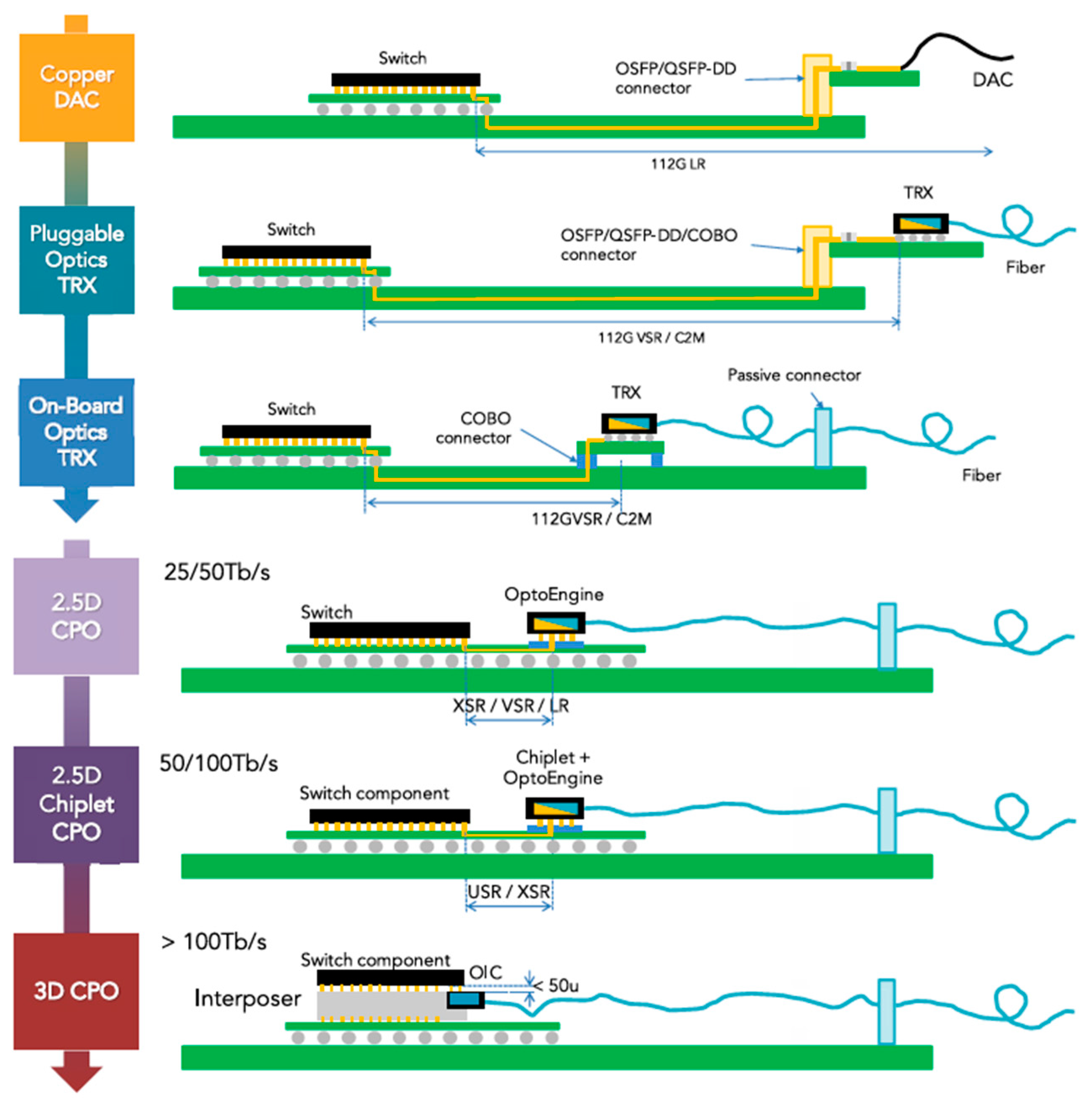
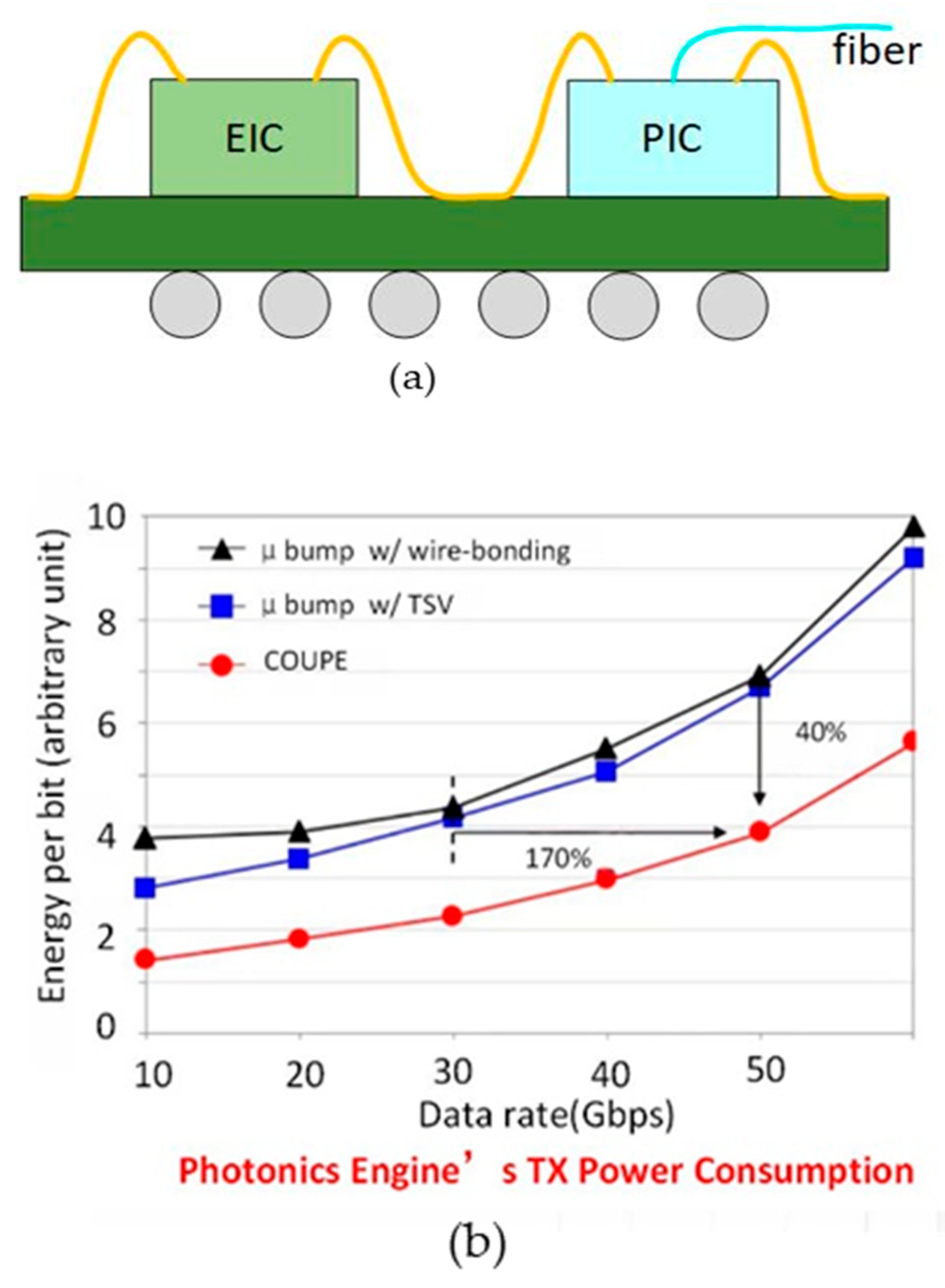


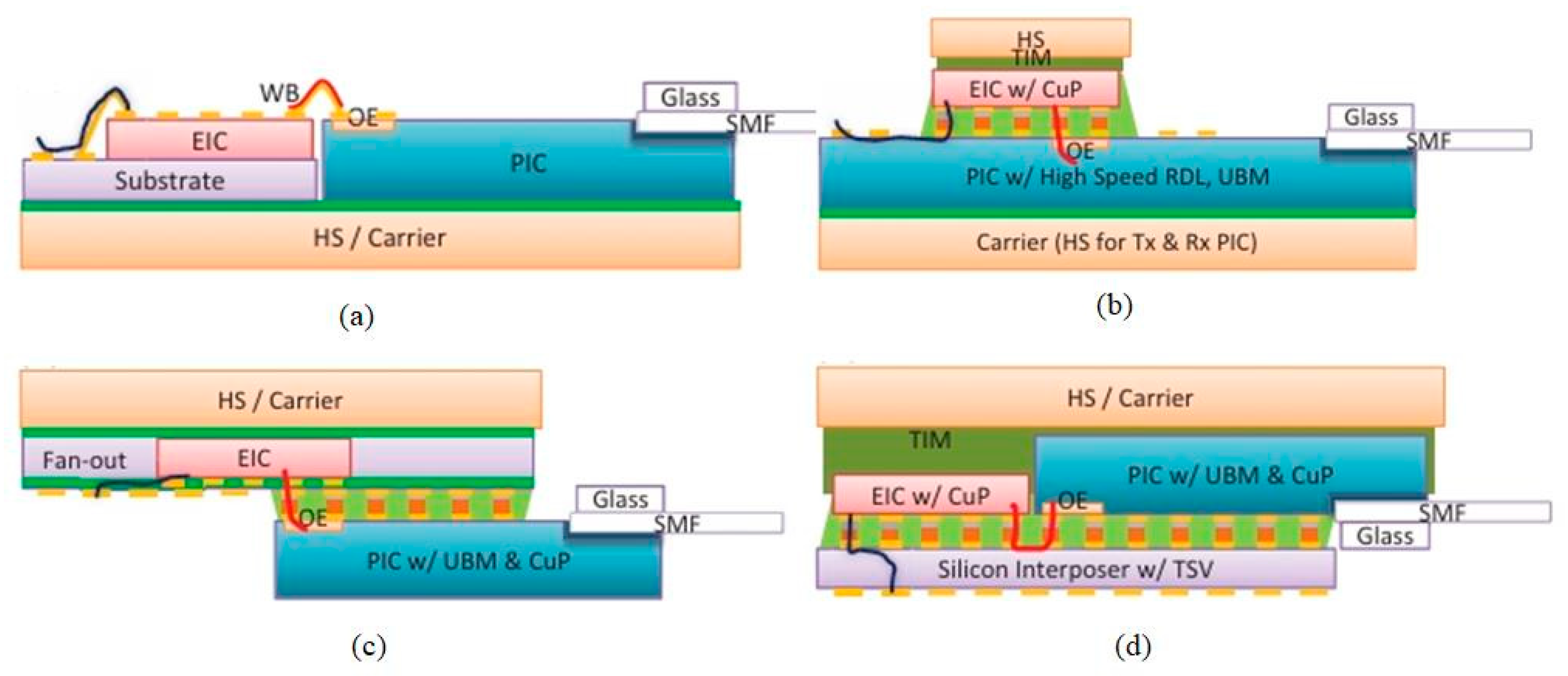
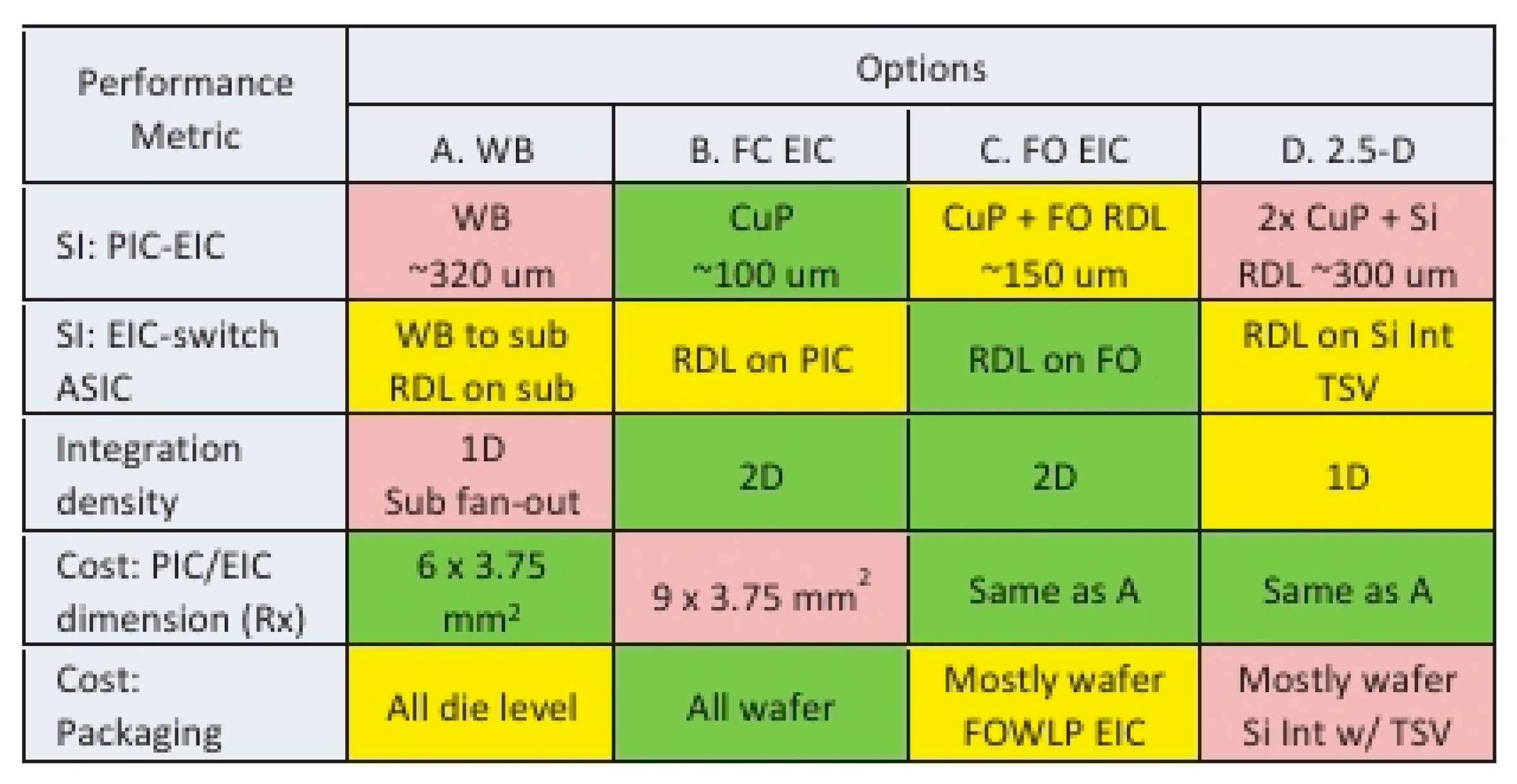
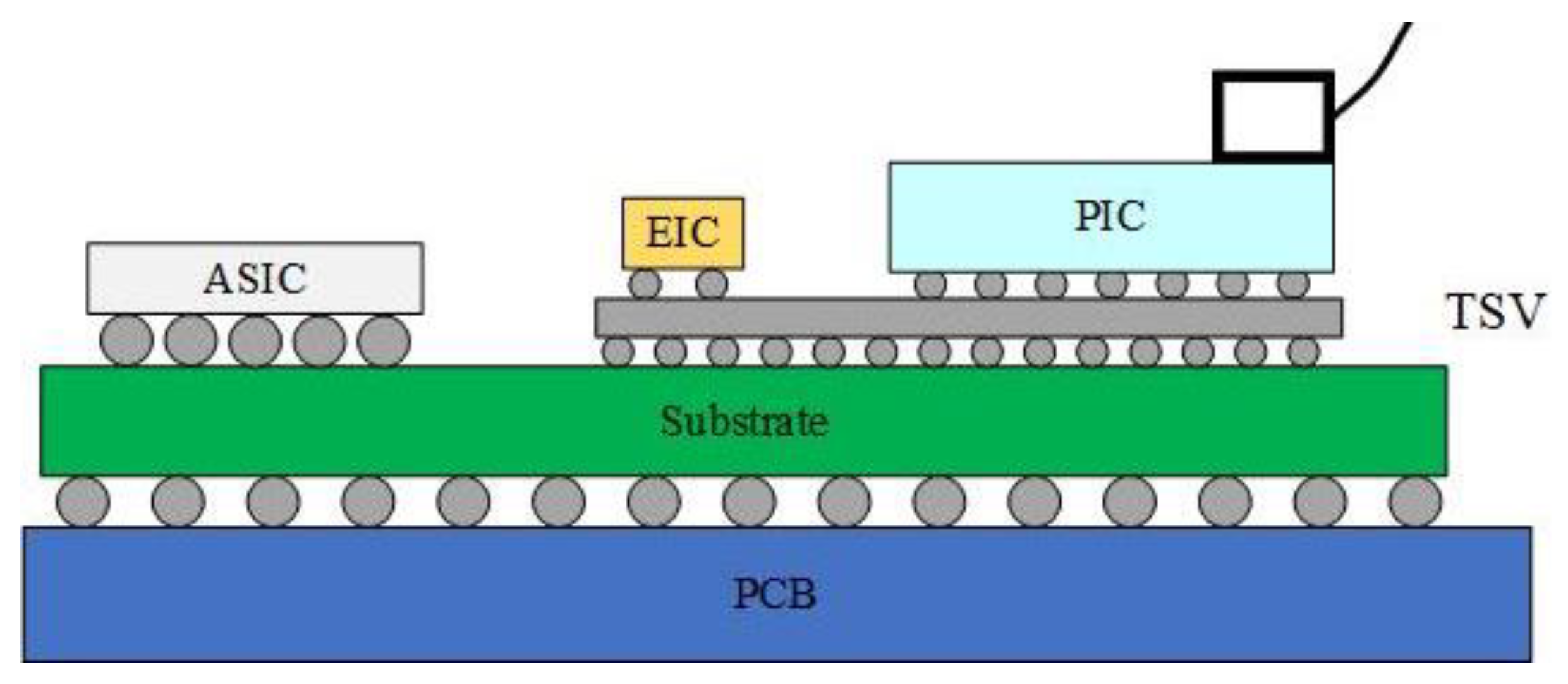
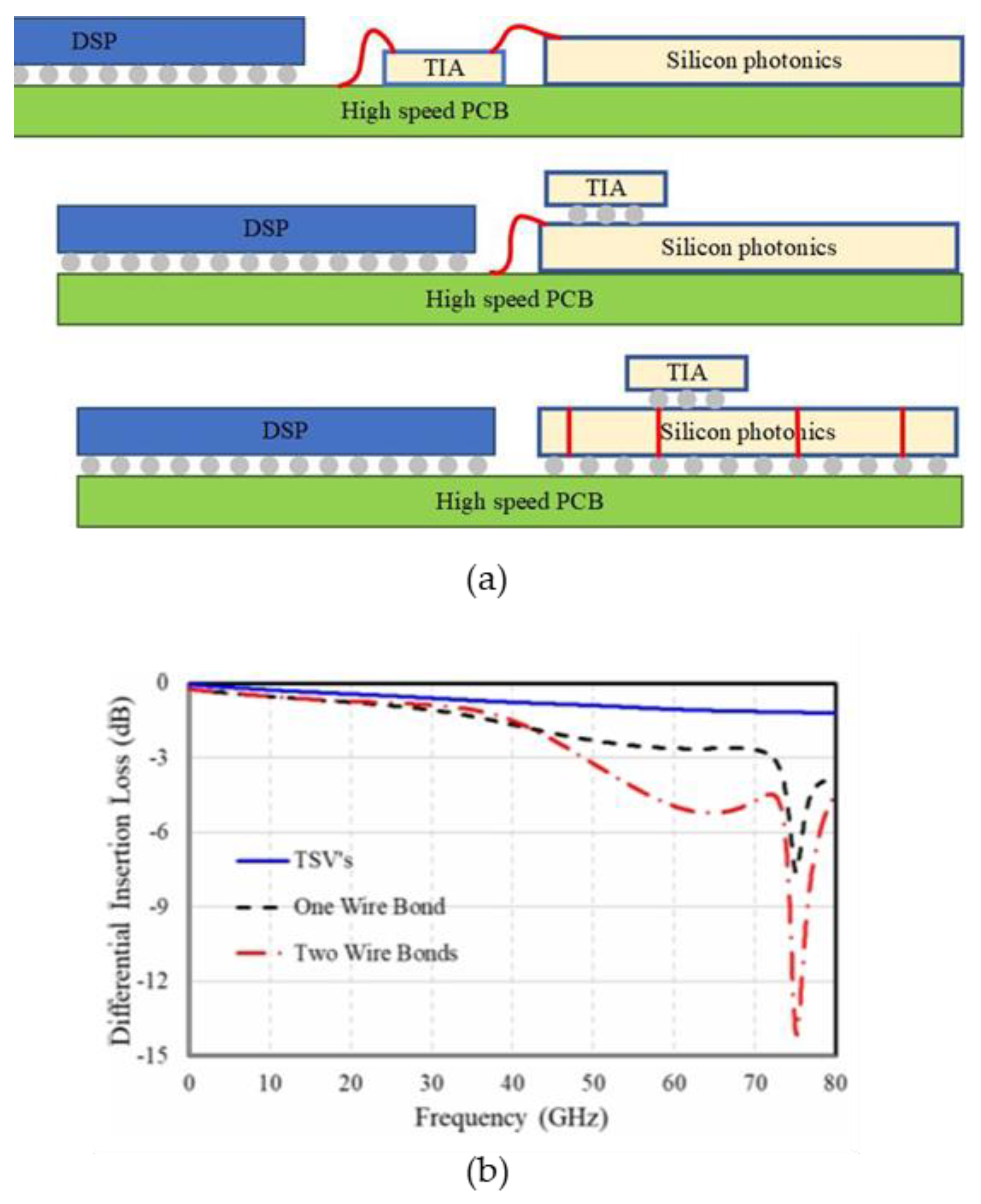
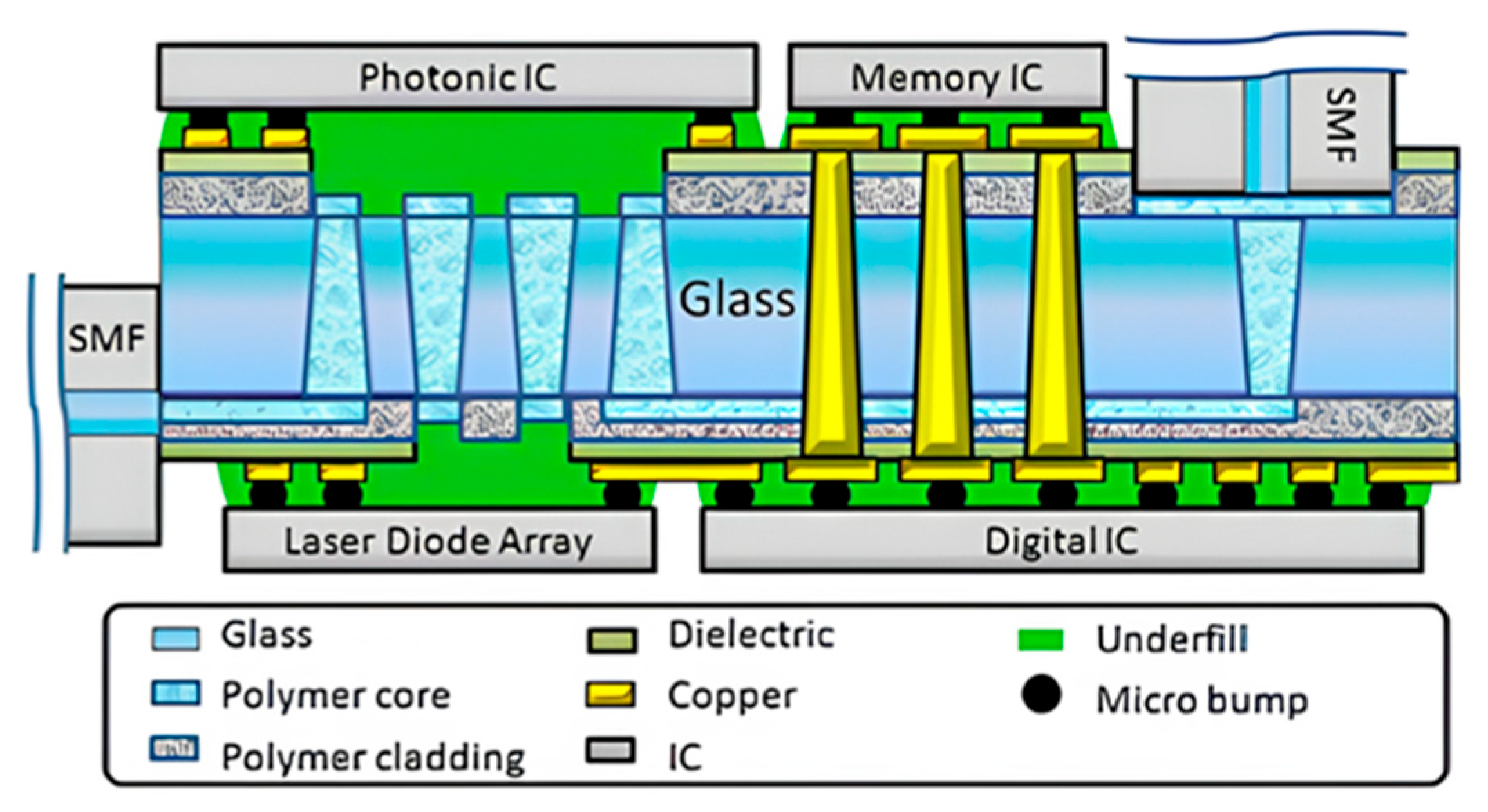

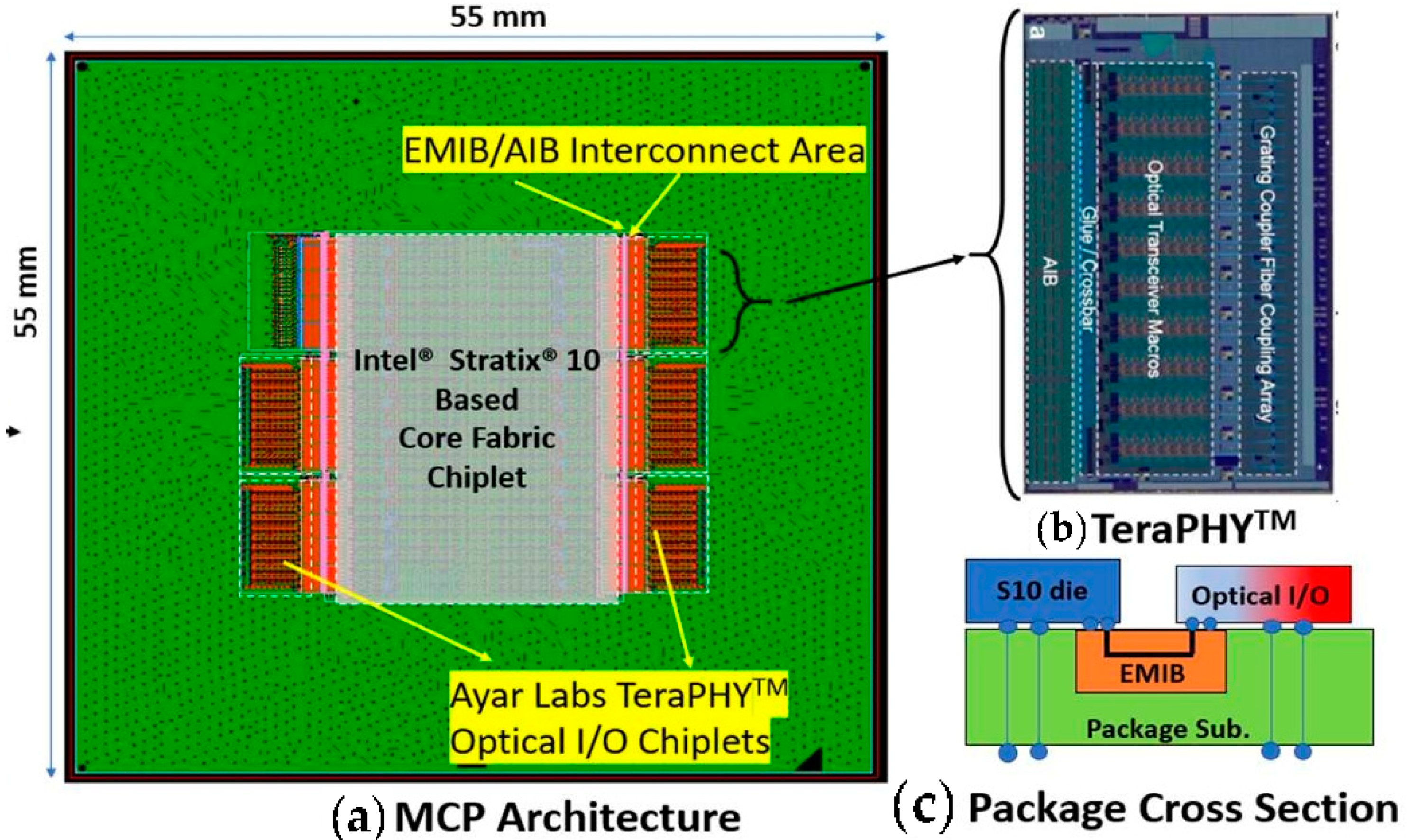

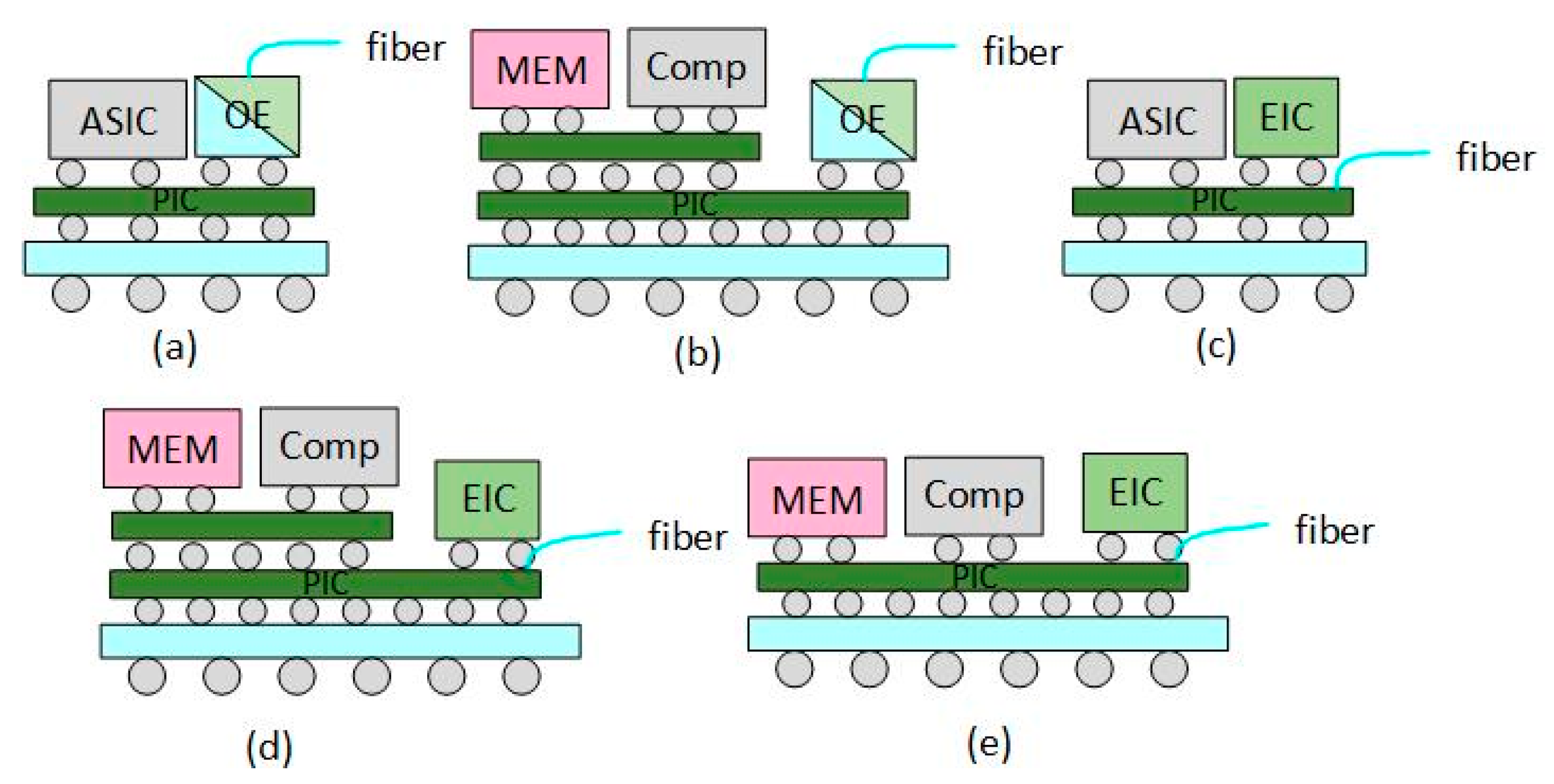
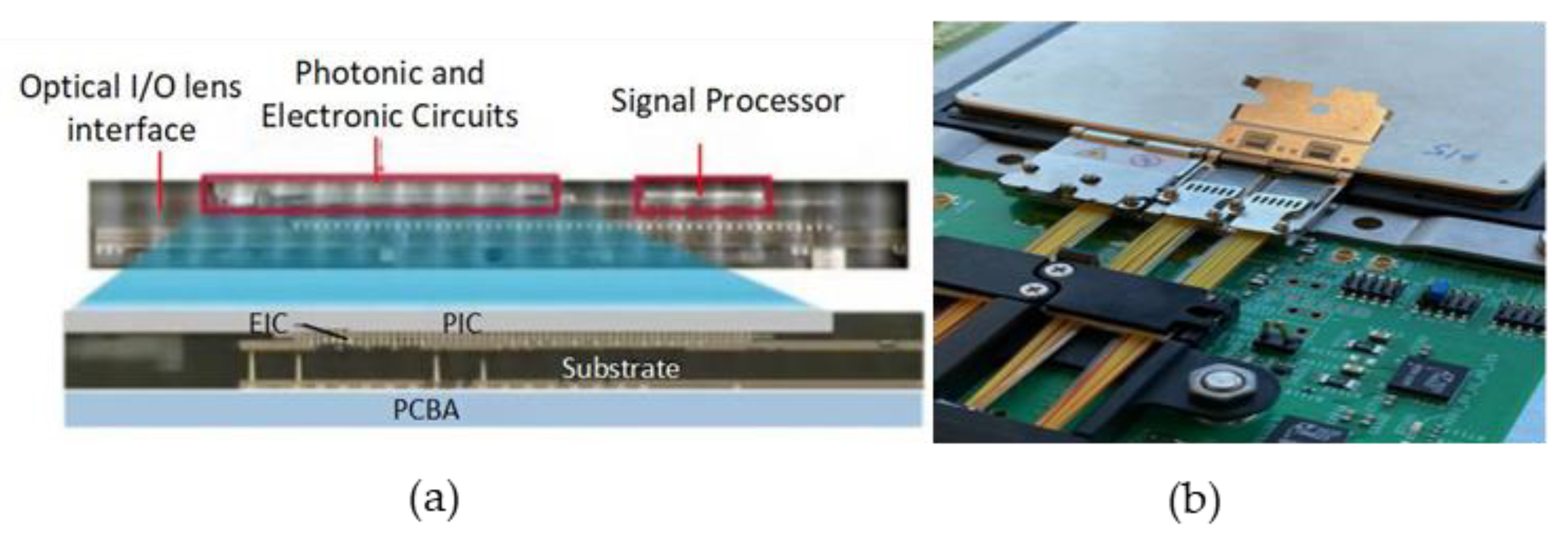

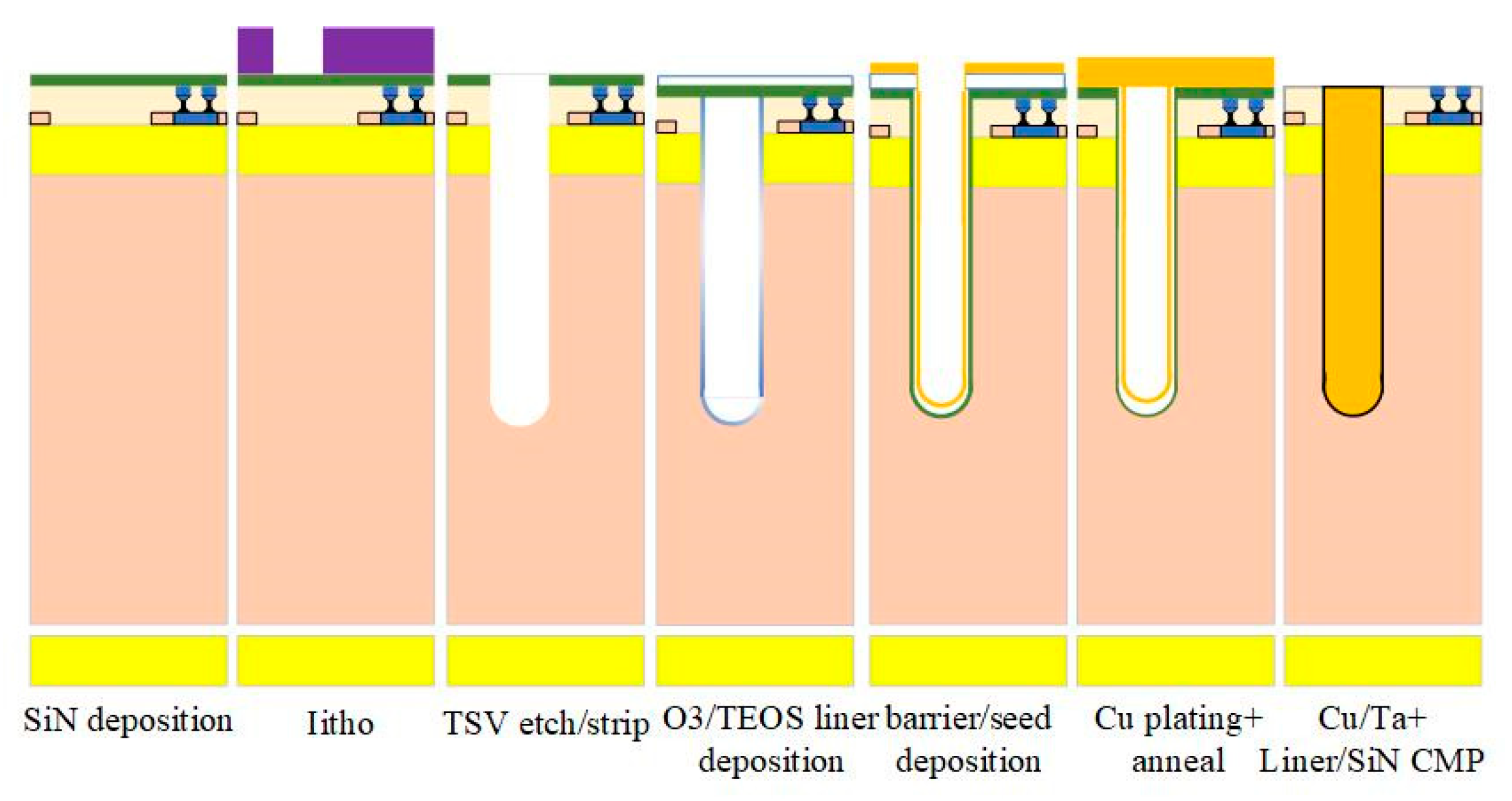
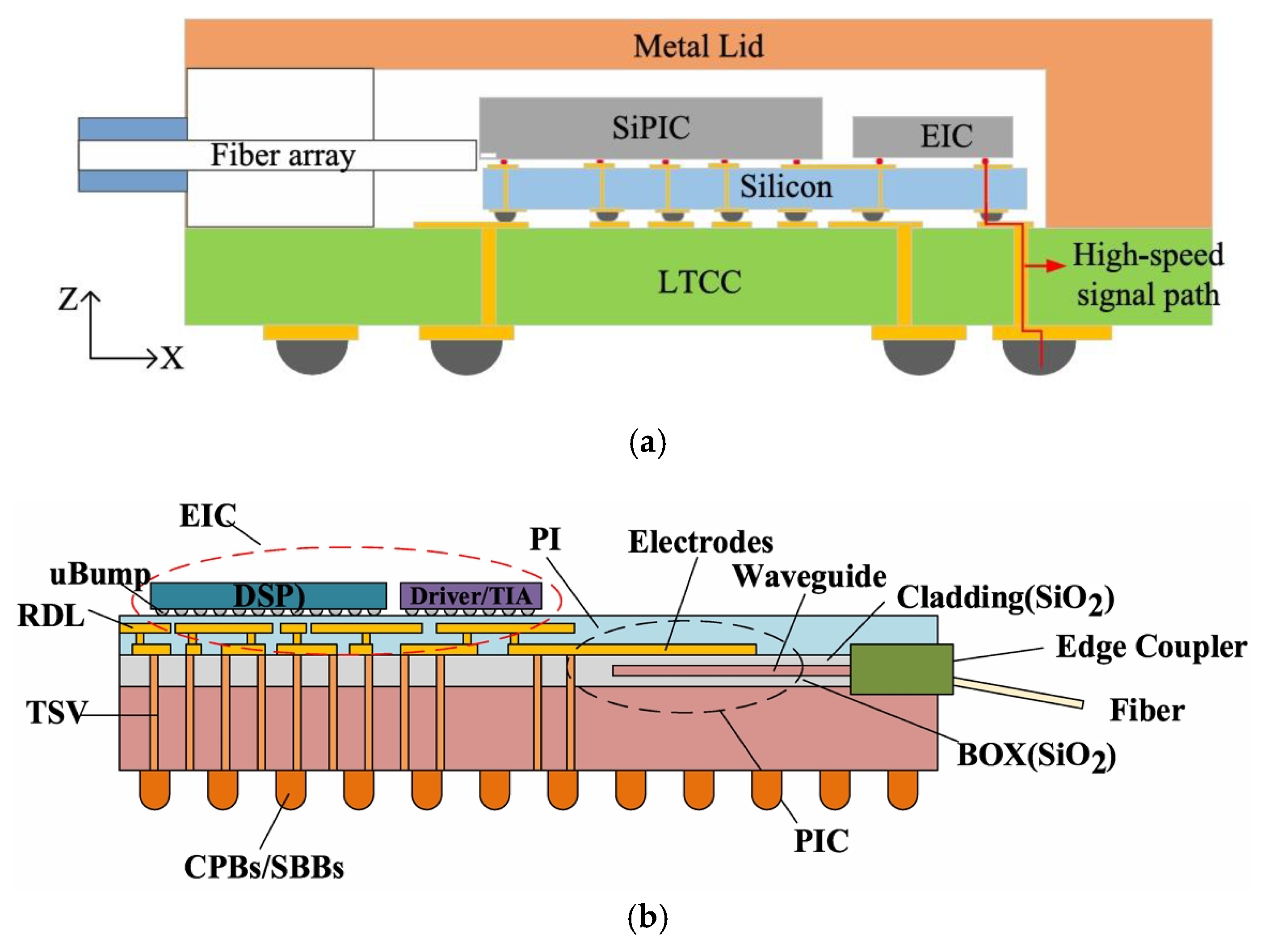
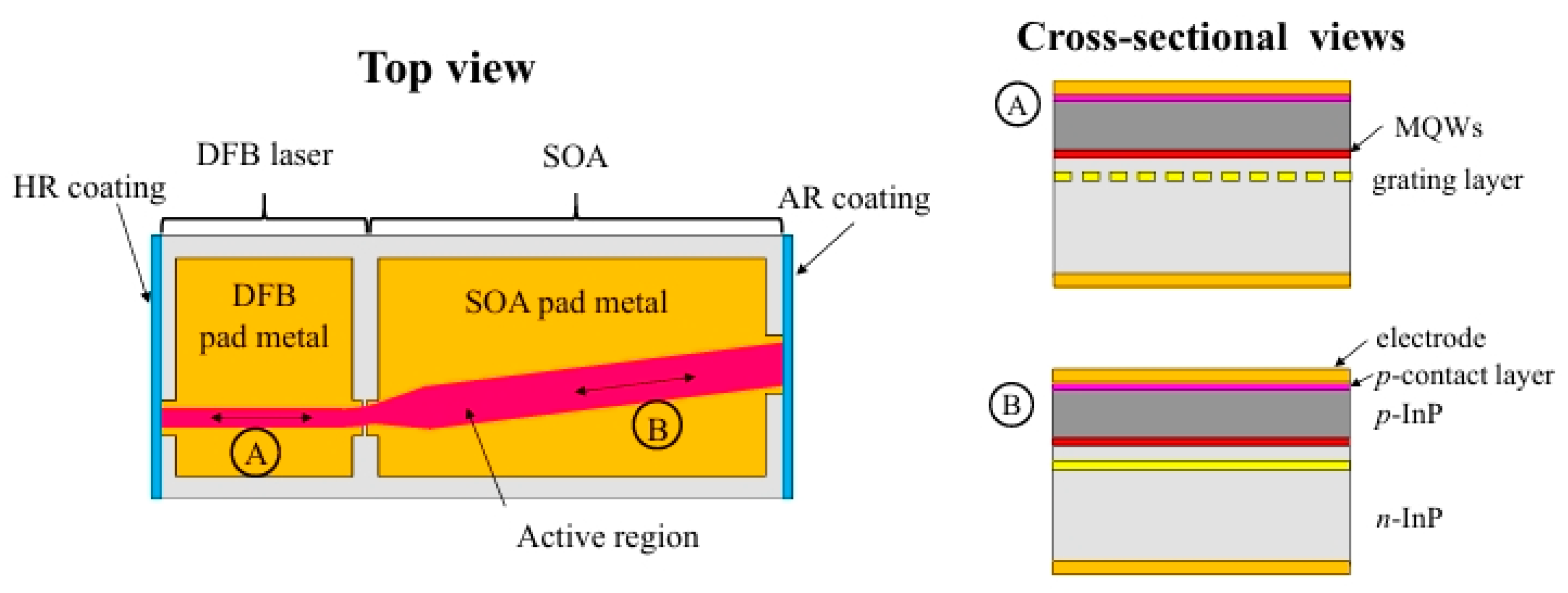
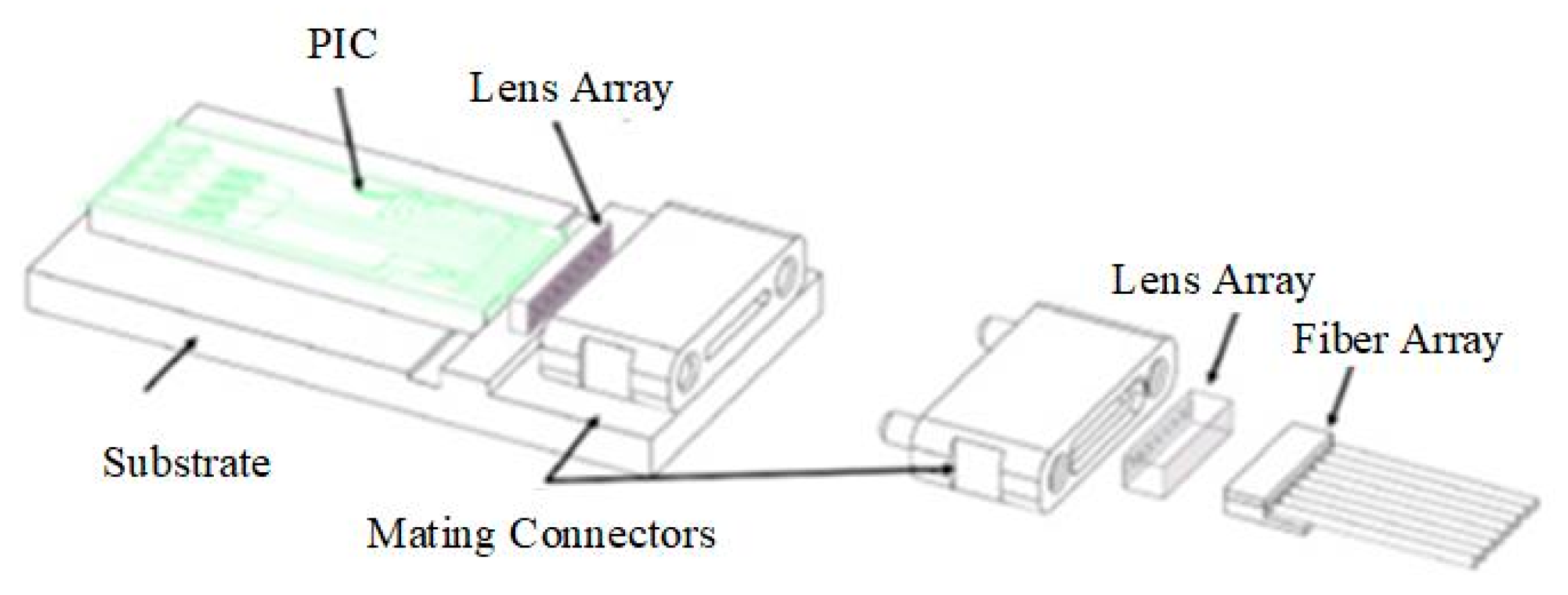
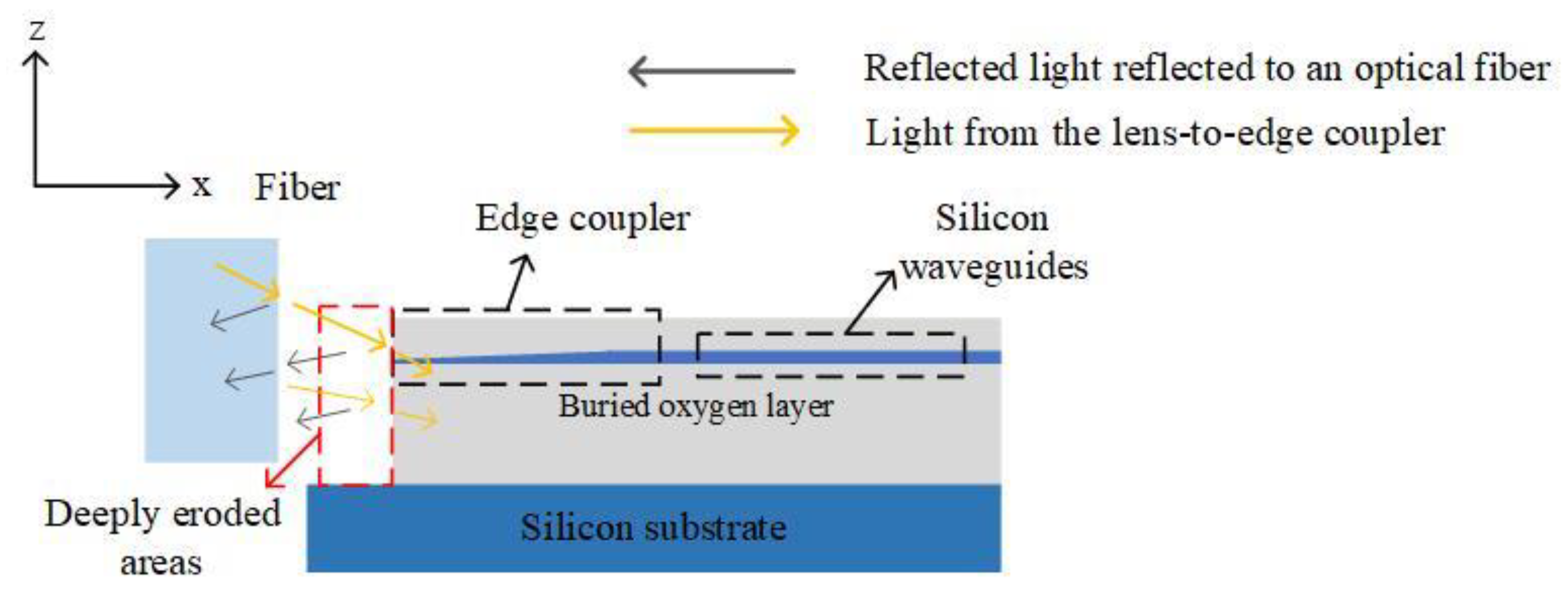
| Company | Light Source | Optical Connection | Electrical Socket | Soldered | Energy Consumption (PJ/bit) |
|---|---|---|---|---|---|
| AMD (Santa Clara, CA, USA)/Ranovus (Ottawa, ON, Canada) | Integrated or remote | √ | 5 | ||
| Broadcom (Irvine, CA, USA) | Remote | √ | √ | 5 | |
| Cisco(San Jose, CA, USA) | Remote | √ | 5 | ||
| Intel (Santa Clara, CA, USA) | Integrated | √ | √ | √ | 1.3 |
| Marvell (Silicon Valley, CA, USA) | Integrated | √ | 5 |
| IBM | HPE | Fujitsu | Furukawa | |
|---|---|---|---|---|
| Electrical Interface | 16 × 56 Gbps NRZ | 4 × 112 Gbps PAM4 | 16 × 25 Gbps NRZ | 8 × 56 Gbps PAM4 |
| IC technology | 55 nm BiCMOS | NA | NA | NA |
| Wavelength/nm | 940 | 990/1015/1040/1065 | 1060 | 1060 |
| Laminate interface | Solder or LGA | NA | LGA | LGA |
| Footprint/ | 13 × 13 × 6 | NA | 7.8 × 16 × 8.0 | 15.9 × 7.7 × 7.95 |
| Data rate/Gbps | 800 | 400 | 400 | 400 |
| Energy Consumption(pJ/bit) | 4.2 | NA | NA | NA |
| Bidirectional Bandwidth Density/(Gbps/) | 10.60 | NA | 6.41 | 7.32 |
Disclaimer/Publisher’s Note: The statements, opinions and data contained in all publications are solely those of the individual author(s) and contributor(s) and not of MDPI and/or the editor(s). MDPI and/or the editor(s) disclaim responsibility for any injury to people or property resulting from any ideas, methods, instructions or products referred to in the content. |
© 2024 by the authors. Licensee MDPI, Basel, Switzerland. This article is an open access article distributed under the terms and conditions of the Creative Commons Attribution (CC BY) license (https://creativecommons.org/licenses/by/4.0/).
Share and Cite
Tian, W.; Hou, H.; Dang, H.; Cao, X.; Li, D.; Chen, S.; Ma, B. Progress in Research on Co-Packaged Optics. Micromachines 2024, 15, 1211. https://doi.org/10.3390/mi15101211
Tian W, Hou H, Dang H, Cao X, Li D, Chen S, Ma B. Progress in Research on Co-Packaged Optics. Micromachines. 2024; 15(10):1211. https://doi.org/10.3390/mi15101211
Chicago/Turabian StyleTian, Wenchao, Huahua Hou, Haojie Dang, Xinxin Cao, Dexin Li, Si Chen, and Bingxu Ma. 2024. "Progress in Research on Co-Packaged Optics" Micromachines 15, no. 10: 1211. https://doi.org/10.3390/mi15101211








